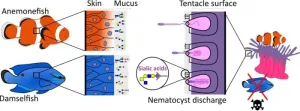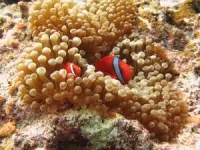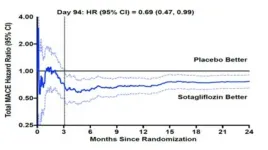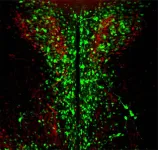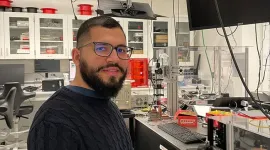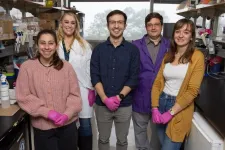(Press-News.org) The clownfish-anemone living arrangement is one of the most widely recognized examples of symbiosis. Researchers have made a breakthrough in understanding how anemonefish can live safely among sea anemones without being stung by their venomous tentacles, solving a century-long mystery.
Scientists at the Okinawa Institute of Science and Technology (OIST) and their international collaborators have discovered that anemonefish have evolved to maintain very low levels of sialic acid in their skin mucus to avoid triggering the release of nematocysts (stinging cells) in their sea anemone hosts. The researchers found that sea anemones also lack these sugar compounds in their own mucus, likely to avoid stinging themselves. Their findings, published in the journal BMC Biology, suggest anemonefish might be using a similar protective strategy to their hosts.
Comparing symbiotic and non-symbiotic species
The study combined multiple approaches, including glycobiology (the study of sugars) and transcriptomics – the study of all RNA molecules produced by an organism's genome to understand gene expression and regulation. The researchers measured and analyzed mucus samples from both anemonefish and non-symbiotic damselfish species, using advanced techniques to separate and analyze the components of a mixture (liquid chromatography).
Sialic acids are important sugar molecules naturally present in most living organisms that play important roles in cellular processes such as cell-cell interactions and protein communication. Previous studies have shown that these molecules can trigger the release of sea anemone stinging cells. Very interestingly, scientists found that while anemonefish maintain certain levels of sialic acid in their internal organs like the brain and gut, they have specifically evolved to have very low levels in their protective mucus layer compared to non-symbiotic damselfish.
They also studied a unique case of the domino damselfish, which can live with anemones as juveniles. They found that these fish also show reduced sialic acid levels in their mucus during their juvenile stage, suggesting that different species have evolved similar adaptations for achieving symbiosis with sea anemones.
A particularly interesting finding was the correlation between sialic acid levels and the developmental stages of anemonefish. Young larvae, which are not yet ready to live with sea anemones, have normal sialic acid levels and get stung if they approach an anemone. However, when they metamorphose and develop their characteristic white stripes and bright orange coloring, their sialic acid levels drop, allowing them to safely enter the anemone.
“Our findings represent a major advancement because it's one of the first studies to combine glycobiology with transcriptomic analysis to investigate this mechanism,” Dr. Natacha Roux, a researcher at Centre de Recherches Insulaires et Observatoire de l’Environnement (CRIOBE) and former researcher in OIST’s Computational Neuroethology Unit, elaborated.
Adapting for co-existence
The research team has two main hypotheses about how anemonefish maintain low sialic acid levels: either their mucus-producing cells express high levels of enzymes that cut sialic acid, or bacteria in their mucus microbiome are responsible for breaking it down. The second hypothesis is supported by previous observations that when anemonefish and sea anemones live together, their bacterial flora converge over time.
Prof. Vincent Laudet, head of OIST’s Marine Eco-Evo-Devo Unit emphasized that this is likely just one part of a complex symbiotic relationship. “Other factors might include the thickness of fish scales, the exchange of nutrients between species, and possible adjustments by the anemones themselves. The relationship is mutually beneficial, with anemonefish receiving protection from predators while helping to defend the anemone and providing nutritional benefits,” he said.
Future research aims to provide ultimate proof of this mechanism by attempting to manipulate the system – making anemonefish sensitive to anemone stings and non-symbiotic fish resistant. However, this is technically challenging and remains a work in progress. The study is also significant because it represents the first major paper from a new international research laboratory collaboration between France’s National Centre for Scientific Research (CNRS) and OIST.
END
Marine mystery solved: How anemonefish avoid stings from their sea anemone hosts
Molecular cloaking mechanism explains iconic anemonefish-anemone partnership
2025-02-15
ELSE PRESS RELEASES FROM THIS DATE:
A diabetes, heart failure, and kidney disease medication is the first of its kind to significantly reduce both heart attacks and strokes
2025-02-15
Sotagliflozin, a drug recently approved by the Food and Drug Administration to treat type 2 diabetes and kidney disease with additional cardiovascular risk factors, can significantly reduce heart attack and stroke among these patients, according to results from an international clinical trial led by a Mount Sinai researcher.
Sotagliflozin is a sodium-glucose cotransporter (SGLT) inhibitor. It blocks the function of two proteins, known as SGLT1 and SGLT2, which move glucose and sodium across cell membranes and help control blood sugar levels. Other SGLT2 inhibitors do not as significantly block SGLT1.
The study, published ...
Researchers discover how opsin 3, a light-sensitive brain protein, regulates food consumption in mice
2025-02-14
PROVIDENCE, R.I. [Brown University] — Scientists discovered years ago that the hypothalamus — which helps to manage body temperature, hunger, sex drive, sleep and more — includes neurons that express the protein opsin 3 (OPN3). Far less clear, however, was what this light-sensing protein does so deep inside the brain.
A study published in PNAS suggests that OPN3 plays an important role in regulating food consumption.
“Our results uncover a mechanism by which the nonvisual opsin ...
New blood test could improve Alzheimer’s Disease diagnosis, research finds
2025-02-14
New blood test could improve Alzheimer’s Disease diagnosis, research finds
Up to half of all people living with Alzheimer’s Disease in Ireland remain undiagnosed. Now, a new blood test may have the potential to transform patient care, allowing for better diagnosis, earlier interventions and more targeted treatments.
Researchers at Trinity College Dublin, the Tallaght Institute of Memory and Cognition and St James’s Hospital, Dublin are exploring the ability of a new blood test, plasma p-tau217, to detect Alzheimer’s Disease (AD). This test could potentially replace the current diagnostic method, a lumbar puncture/spinal tap (which ...
Outstanding Cal Poly public health faculty member and global health advocate among first Faculty Excellence Award honorees
2025-02-14
Cal Poly Assistant Professor Joni Roberts has been chosen, with two additional university faculty members, as the first Cal Poly Faculty Excellence Award honorees.
The inaugural Faculty Excellence Award — an honor recognizing outstanding contributions in teaching, research and service — is administered by the Office of the Provost and funded by generous donor contributions. The award reflects Cal Poly’s commitment to academic excellence and its Learn by Doing philosophy.
The ...
Trees might need our help to survive climate change, CSU study finds
2025-02-14
A new Colorado State University study of the interior U.S. West has found that tree ranges are generally contracting in response to climate change but not expanding into cooler, wetter climates – suggesting that forests are not regenerating fast enough to keep pace with climate change, wildfire, insects and disease.
As the climate becomes too warm for trees in certain places, tree ranges have been expected to shift toward more ideal conditions. The study analyzed national forest inventory data for more than 25,000 plots in ...
Terabytes of data in a millimeter crystal
2025-02-14
From punch card-operated looms in the 1800s to modern cellphones, if an object has an “on” and an “off” state, it can be used to store information.
In a computer laptop, the binary ones and zeroes are transistors either running at low or high voltage. On a compact disc, the one is a spot where a tiny indented “pit” turns to a flat “land” or vice versa, while a zero is when there’s no change.
Historically, the size of the object making the “ones” and “zeroes” has put a limit on the size of the storage device. But now, University of Chicago Pritzker School of Molecular ...
New technology enhances gravitational-wave detection
2025-02-14
RIVERSIDE, Calif. -- In a paper published earlier this month in Physical Review Letters, a team of physicists led by Jonathan Richardson of the University of California, Riverside, showcases how new optical technology can extend the detection range of gravitational-wave observatories such as the Laser Interferometer Gravitational-Wave Observatory, or LIGO, and pave the way for future observatories.
Since 2015, observatories like LIGO have opened a new window on the universe. Plans for future upgrades to the 4-kilometer LIGO detectors and the construction of a next-generation 40-kilometer observatory, Cosmic Explorer, aim to push the gravitational-wave ...
Gene therapy for rare epilepsy shows promise in mice
2025-02-14
Dravet syndrome and other developmental epileptic encephalopathies are rare but devastating conditions that cause a host of symptoms in children, including seizures, intellectual disability, and even sudden death.
Most cases are caused by a genetic mutation; Dravet syndrome in particular is most often caused by variants in the sodium channel gene SCN1A.
Recent research from Michigan Medicine takes aim at another variant in SCN1B, which causes an even more severe form of DEE.
Mice without the SCN1B gene experience seizures and 100 percent mortality just ...
Scientists use distant sensor to monitor American Samoa earthquake swarm
2025-02-14
In late July to October 2022, residents of the Manu’a Islands in American Samoa felt the earth shake several times a day, raising concerns of an imminent volcanic eruption or tsunami.
An earthquake catalog for the area turned up nothing, because the islands lacked a seismic monitoring network that could measure the shaking and aid seismologists in their search for the source of the earthquake swarm.
But the residents of the Taʻū, Ofu, and Olosega islands needed answers, so Clara Yoon of the ...
New study explains how antidepressants can protect against infections and sepsis
2025-02-14
LA JOLLA (February 14, 2025)—Antidepressants like Prozac are commonly prescribed to treat mental health disorders, but new research suggests they could also protect against serious infections and life-threatening sepsis. Scientists at the Salk Institute have now uncovered how the drugs are able to regulate the immune system and defend against infectious disease—insights that could lead to a new generation of life-saving treatments and enhance global preparedness for future pandemics.
The Salk study follows recent findings that users of selective ...
LAST 30 PRESS RELEASES:
Interaction of climate change and human activity and its impact on plant diversity in Qinghai-Tibet plateau
From addressing uncertainty to national strategy: an interpretation of Professor Lim Siong Guan’s views
Clinical trials on AI language model use in digestive healthcare
Scientists improve robotic visual–inertial trajectory localization accuracy using cross-modal interaction and selection techniques
Correlation between cancer cachexia and immune-related adverse events in HCC
Human adipose tissue: a new source for functional organoids
Metro lines double as freight highways during off-peak hours, Beijing study shows
Biomedical functions and applications of nanomaterials in tumor diagnosis and treatment: perspectives from ophthalmic oncology
3D imaging unveils how passivation improves perovskite solar cell performance
Enriching framework Al sites in 8-membered rings of Cu-SSZ-39 zeolite to enhance low-temperature ammonia selective catalytic reduction performance
AI-powered RNA drug development: a new frontier in therapeutics
Decoupling the HOR enhancement on PtRu: Dynamically matching interfacial water to reaction coordinates
Sulfur isn’t poisonous when it synergistically acts with phosphine in olefins hydroformylation
URI researchers uncover molecular mechanisms behind speciation in corals
Chitin based carbon aerogel offers a cleaner way to store thermal energy
Tracing hidden sources of nitrate pollution in rapidly changing rural urban landscapes
Viruses on plastic pollution may quietly accelerate the spread of antibiotic resistance
Three UH Rainbow Babies & Children’s faculty elected to prestigious American Pediatric Society
Tunnel resilience models unveiled to aid post-earthquake recovery
Satellite communication systems: the future of 5G/6G connectivity
Space computing power networks: a new frontier for satellite technologies
Experiments advance potential of protein that makes hydrogen sulfide as a therapeutic target for Alzheimer’s disease
Examining private equity’s role in fertility care
Current Molecular Pharmacology achieves a landmark: real-time CiteScore advances to 7.2
Skeletal muscle epigenetic clocks developed using postmortem tissue from an Asian population
Estimating unemployment rates with social media data
Climate policies can backfire by eroding “green” values, study finds
Too much screen time too soon? A*STAR study links infant screen exposure to brain changes and teen anxiety
Global psychiatry mourns Professor Dan Stein, visionary who transformed mental health science across Africa and beyond
KIST develops eco-friendly palladium recovery technology to safeguard resource security
[Press-News.org] Marine mystery solved: How anemonefish avoid stings from their sea anemone hostsMolecular cloaking mechanism explains iconic anemonefish-anemone partnership
